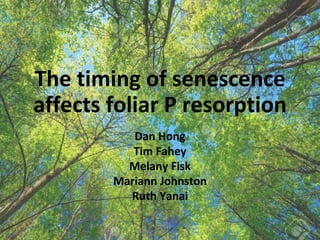
The timing of senescence affects foliar p resorption dan hong
- 1. The timing of senescence affects foliar P resorption Dan Hong Tim Fahey Melany Fisk Mariann Johnston Ruth Yanai
- 2. Before the leaves fall… • Trees retranslocate nutrients from senescing leaves ⮚ Nutrient conservation and recycling prior to frost damage = foliar resorption
- 3. Research questions • How do foliar concentration and resorption vary with respect to nutrient additions (N, P, & N+P)? • How do species vary in foliar concentration and resorption with nutrient additions? • Does the timing of senescence affect foliar resorption with nutrient additions? • If so, do certain species resorb more nutrients earlier in the litterfall season, or later?
- 4. Field collections • Green leaves collected by species between late July and beginning of August in 2016. • Fresh litter collected in baskets and sorted by species in the Fall. ⮚Trip1: 10/7 – 10/9 ⮚Trip2: 10/17 – 10/19 ⮚Trip3: 10/21 – 10/23 ⮚Trip4: 11/4 – 11/6 = 653 samples
- 5. Laboratory methods • P and other elements by Optima 5300 DV ICP-OES (Perkin-Elmer) • Green leaves were ashed and hotplate-digested • Fresh litter was microwave-digested by MARS 6 Microwave Digestion System (CEM) • N by a FlashEA 1112 analyzer (Thermo Scientific)
- 6. • N addition ↗ N (p < 0.01) ↘ P (p < 0.01) • P addition ↗ P (p < 0.01) • Species (p < 0.01) Green leaves Solid 🡪 N:P of 14-16 Dotted 🡪 N:P of 10-20 PC
- 7. Fresh litter P concentrations American beech Pin cherry Red maple Sugar maple White birch Yellow birch Oct. Nov. Oct. Nov. Oct. Nov. 2.0 1.5 1.0 0.5 0.0 2.0 1.5 1.0 0.5 0.0 Pconcentration(mg/g)
- 8. P resorption efficiency Young American beech Pin cherry Young White birch Yellow birch Young + mid-aged Mid-aged + mature Oct. Nov. Oct. Nov. 80 60 40 80 60 40 PRE(%)
- 9. Summary • Adding N increased foliar N but suppressed foliar P, and adding P increased foliar P. • Indicates P-limitation in our stands. • Pin cherry had the highest foliar and litter N and P. • P resorption efficiency was lower under P additions. • P resorption proceeds over the course of the fall.
Notes de l'éditeur
- Now that you know where you get your leaves matters, thanks to Alex! I’m going to tell you WHEN you get your leaves also matters!
- Before the leaves fall, foliar nutrients are retranslocated as a way to conserve and recycle nutrients. Foliar concentrations and resorptions are important as they can provide a snapshot of how trees allocate their nutrients under different conditions, such as elevated levels of N and P. But due to the time and effort in collecting leaves, foliar resorption studies have been traditionally done by comparing green leaves and fresh litter from only one time in the fall.
- Dominant species were chosen for
- Say I don’t know have N results for litter.
- Adding N increased N concentrations and decreased P concentrations, pushing it towards P-limitation. Adding P increased P concentrations, to a point of co-limitation or even towards N-limitation. Adding N and P together prompted a shift towards co-limitation. PC accumulated more N than the birches. PC accumulated more P than BE or WB.
- Litter P was high with P additions as shown by the red and purple lines for all species (p < 0.01). PC reported the highest litter P concentrations and this may attribute to its higher foliar P concentrations from the previous slide.
- PRE was lowest under P additions. Adding N suppressed PRE over time, though not significant. P resorption efficiency
- Adding N increased N concentrations and decreased P concentrations, pushing it towards P-limitation. Adding P increased P concentrations, to a point of co-limitation or even towards N-limitation. Adding N and P together prompted a shift towards co-limitation. PC accumulated more N than the birches. PC accumulated more P than BE or WB. Foliar N:P ratios increased with N and decreased with P addition. Litter P was high with P additions as shown by the red and purple lines for all species (p < 0.01). PC reported the highest litter P concentrations and this may attribute to its higher foliar P concentrations from the previous slide. PRE was lowest under P additions. Adding N suppressed PRE over time, though not significant.